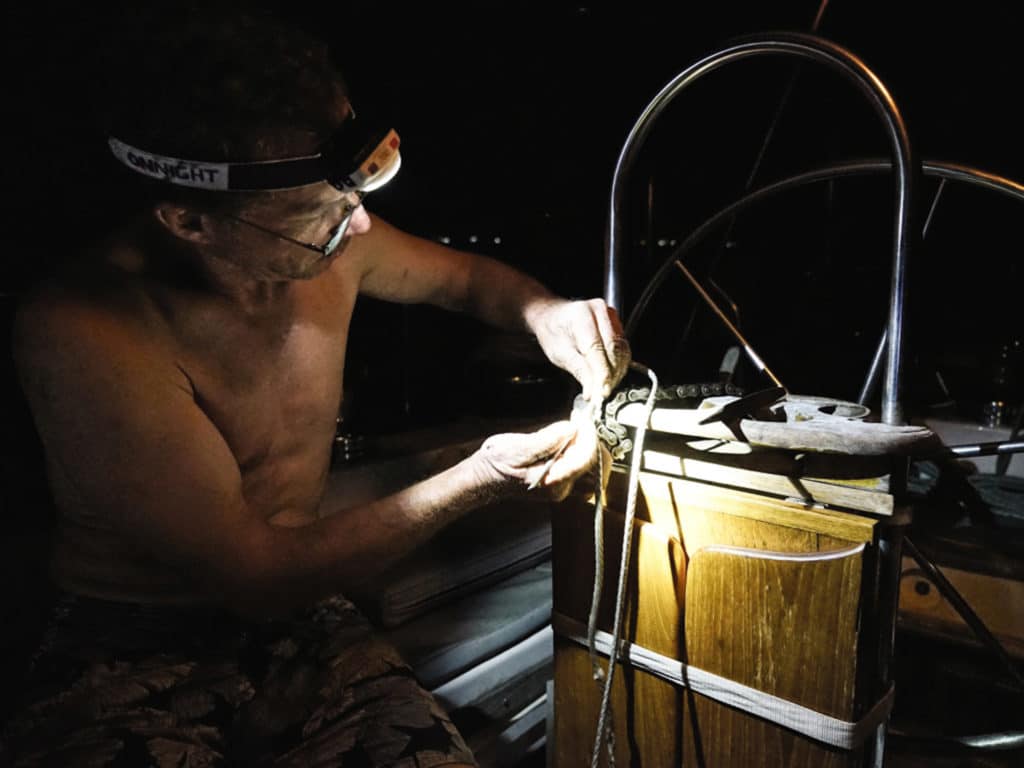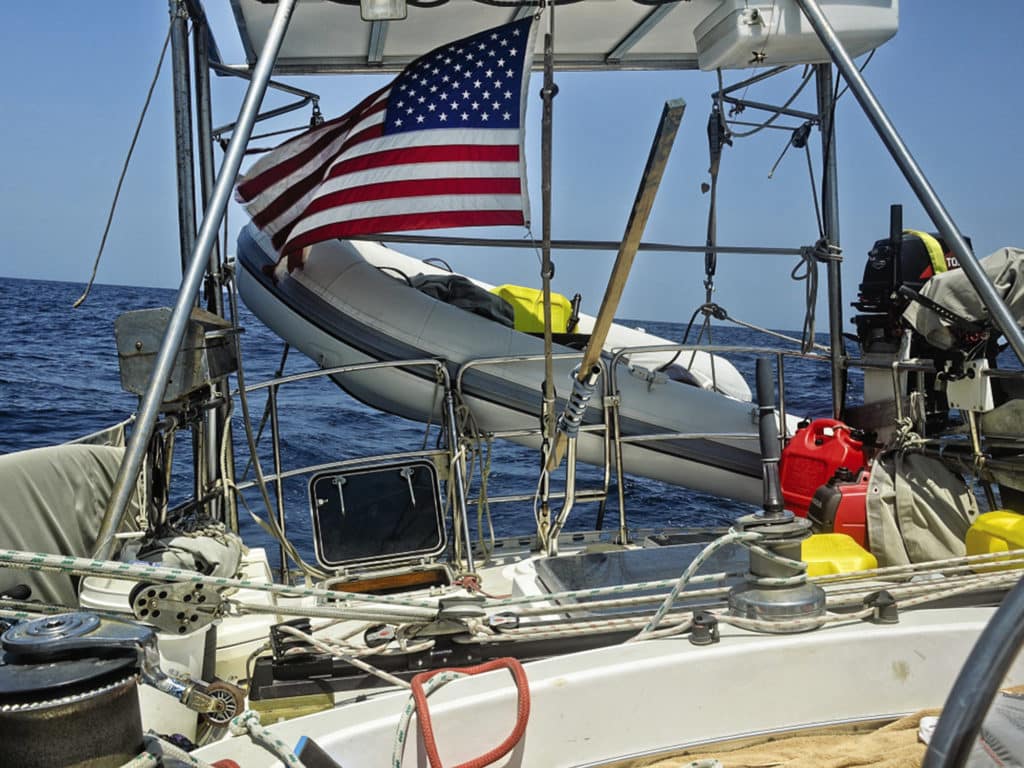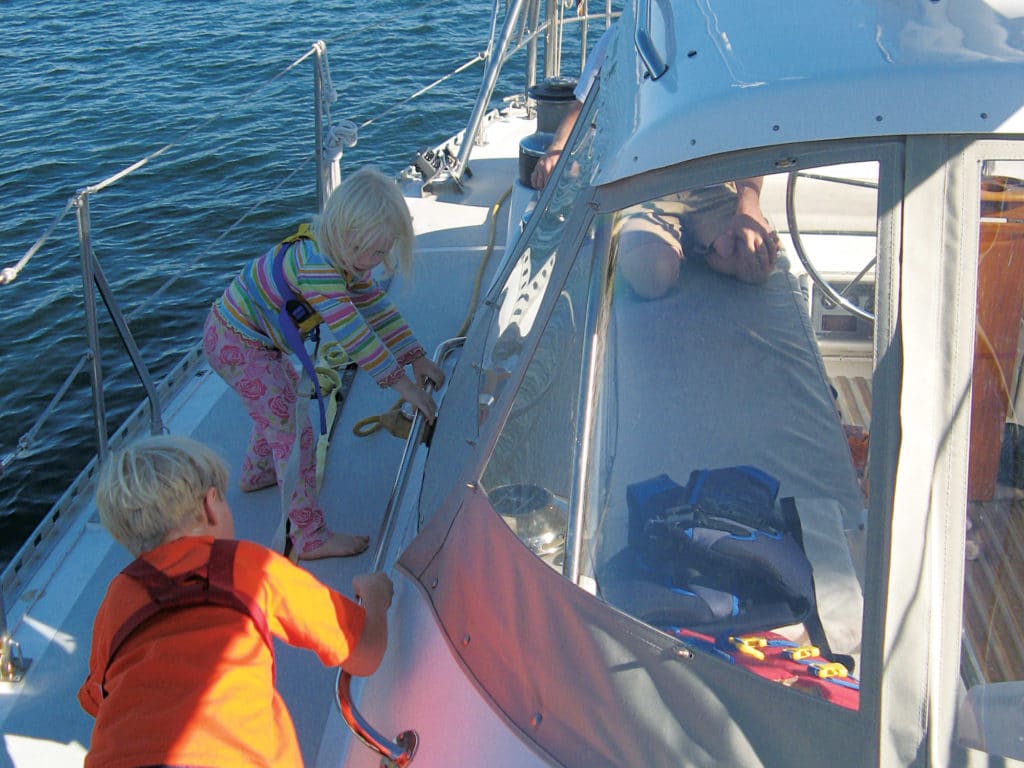
Imagine: You’re on a passage. Stronger than usual Caribbean trades push up a raucous sea. It’s wet, very sporty sailing. Not alarming, but a white-knuckled grip on the dodger frame suggests that’s not too far off. Then, bang! Only simple observations register. The mast is up, sails are drawing, and there’s no jarring impact from hitting something. And there’s confusion. A sound loud enough to pierce this wind must be bad. What you do next is your path forward. How do you prepare for a good outcome?
This very scenario happened to us on Totem while tearing along a remote stretch of Colombia on the way to the San Blas Islands of Panama. The first seconds were tense and fuzzy—no apparent change, but what was about to? Then movement: The wheel was free-wheeling. Totem carved a whitewater path over a wave. We were still on course while the helm was adrift. Then came instant clarity. I understood the problem, risks and solution. I’d imagined it many times before.
Becoming Mindful
By day, the path to cruising involves so much dreaming, but it also involves a lot of boatwork. We add, repair, and refine boat bits and gizmos to perform predictably: new standing rigging to ensure that the mast stays up; new through-hulls, engine service, life-raft certification, better ground tackle. The list goes on, but cruising takes more than good gear. So we train up with sailing instructions, first-aid classes, a safety-at-sea course, a diesel-engine class and person-overboard drills. All excellent preparations! These practiced procedures help sailors better manage unpredictable situations just as astronauts, police, pilots and other professionals routinely train for worst-case scenarios.
By night, the path to cruising can be less dreamy. Rather than dozing off satisfied with being closer to cutting the dock lines, the mind wonders. What’s still unprepared? Worst-case what-ifs creep in. The dark side of the imagination can breed fear, anxiety and even panic. As we prepared Totem to carry our young family to paradise, my wife, Behan, woke many nights shaken by a nightmare scene: a child lost overboard. This terrifying scenario replayed to the same conclusion.
Behan’s other big stressor was owning our children’s education as cruisers. This carried real anxiety for her. Facing this became an intellectual challenge. She jumped into reading what seemed like every book ever written on homeschooling, met home-schooling families, and joined homeschooling communities. Methods and hurdles became familiar. Ideas and opinions formed into a manageable way forward. But still, when sleep came, in her subconscious imagination, another child slipped overboard in another uncontrollable nightmare.
This cruising parent’s worst nightmare faded soon after moving on board. What slayed that monster? Practiced procedures, in the form of safety training. Much like other 4-, 6- and 9-year-olds knew to strap themselves into car seats before the car moved, our children learned that PFDs must be clipped on before reaching the deck. We practiced using handholds moving about the boat. We practiced putting on harnesses and clipping on tethers. Practiced procedures brought familiarity and predictability.
As valuable as practice is, though, it leaves two serious shortcomings. Practice has to be ongoing or it doesn’t stick. For our children, PFD-wearing practice was constant. Stepping into the cockpit PFD-less meant banishment below. They learned well and without ambiguity. Also unambiguous: my tragically bad CPR attempt in an offshore first-aid class that Behan and I recently took. It had been a few years (cough—12—cough) since prior training. The “patient” had no chance under my compressions until I relearned the correct technique.

The other issue is that we can’t practice for all things. How do you practice for sinking? This shortcoming is partially overcome by documented procedures. Laminated cards detailing each through-hull, person-overboard recovery steps and emergency navigation are documented procedures. Nigel Calder’s Boatowner’s Mechanical and Electrical Manual and Dr. Michael Beilan’s Your Offshore Doctor: A Manual of Medical Self-Sufficiency at Sea detail diagnostic and corrective actions. I’m a fresh graduate from a weekend of training with Maritime Medical Guides, gaining fresh skills in sternum-cracking CPR and wound care, but instructional books like these expand my capability immeasurably.
There’s still a void in procedures that cannot be practiced or effectively documented. Time and money could fill in this empty space as it does for other voyagers. For astronauts to prepare for low gravity, NASA built a giant pool and filled it with cool astronaut stuff to practice with. Airplane pilots and commercial-ship officers practice scenarios on ultra-realistic and ultra-costly simulators. Recreational sailors can practice steering failure by what, imagining it?
Picture the Options
On a moonless night watch along the Baja coast, I wondered what I’d do if we lost steering. It’s a pretty remote place to just drop sails and call for help while drifting in circles. I understood (and was capable of) rigging various drag devices to effect steering, but would any of these devices work? Was that all there was to it? What if it wasn’t rudder failure, but rather a different mechanical problem? I had inspected and replaced steering cables at the dock. Could I do so underway?
Imagined troubleshooting brought out too many questions. It was time for answers. I clipped my tether to the aft-leading jackline and followed it back to a lazarette hatch. Headlamp switched on, I opened a hatch and peered below to the quadrant. I could see only part of it. Apparently, I stowed items in the way, despite careful pre-passage prep. I hadn’t imagined needing to get into the lazarette while underway. Clearing the locker was possible in easy conditions but difficult if tossed by waves. Disasters at sea always start on a dark and stormy night, right? What else had I failed to see?
RELATED: Medical Checkups, And A Crisis
Back in the cockpit, red light glowed through the companionway. I scanned the dark horizon for hazards, giving a chuckle thinking that my lazarette stowing job was a hazard! No chance of fixing a steering problem if I couldn’t safely get to the quadrant and the cables. I began to imagine better means of stowage: Keep the path clear and I could get down there, as I’ve done many times at the dock. Shimmy through the hatch, down onto the aft diesel tank, seated. Right foot braced on the quadrant. The moving quadrant! Steering failure plus crushed foot equals cascading failures and a terrible outcome. If my imagined scene was a video game, I’d lost again.
Leaning into the cockpit coaming, I restarted the simulation in my head. With each cycle, the path from cockpit to quadrant became richer with detail. Hidden hazards became obvious. A few minutes on, I reached the next level: a safe position next to steering mechanicals. Now what if I found a broken cable? Failed sheave? Water coming in? This was going to be a long, long game.
Time for Action
Back in Colombia, after the bang! came confusion. Steering wheel spinning. Totem carving a channel through white water. Steering problem—and in a flash, I was in a familiar place. Totem’s autopilot is connected to a tiller arm on the rudder post, independent of the quadrant. Rudder, rudder post, tiller arm and autopilot must be working to keep us on course. The fault must be between the quadrant and steering chain inside the binnacle. The situation wasn’t severe, but in those conditions, a misstep could lead to a second problem, and a third, cascading out of control. Keep this a single-problem event, I told myself. Remember the safe steps you worked out during that long watch off Baja.
Step 1: Communication. Explain the problem and the plan to the crew. Gauge their reaction; any panic needs to be managed. Get them involved: VHF-call to inform friends sailing nearby, and monitor sea state, course and any unexpected changes. Get acknowledgement of understanding.
Step 2: Triage. I imagined that a slack steering cable could jam the quadrant and lock up all steering. This would be a bad second problem, so I needed to prevent this. Crawling into the lazarette was tricky in this sea state, but the path was clear. I positioned myself to remain clear of the moving parts and braced in. No injuries, I reminded myself. The steering cables were loose, as expected, and still attached to the quadrant. I needed to clear the cables from the quadrant, but my mind flashed to my training and my imagined gruesome crush injury. Pause. Watch and understand movements; there is time. Reaching clear under the quadrant, I pulled the cables down and secured them in place under a coiled line. No more risk of jamming.
Next, I needed to find the break because it wasn’t at the quadrant. I informed the crew. They informed me that our buddy boat was standing by for assistance.
In the main cabin, to the right of the galley sink is a locker below the pedestal. Draped across a shelf inside it were two steering cables. One had a length of chain attached. The other had a single, jagged chain link. Source of the problem was confirmed.
Step 3: Stabilize. Our original destination was postponed. Our new options were to go upwind 10 miles back to Santa Marta in rough conditions, or carry on 65 miles and tuck in behind Punta Morro Hermoso. An arrival time check showed that we’d get to Punta Morro just before dark, and we had a chart of the area, so we carried on with sails trimmed with two reefs in the main and partially furled genoa. I imagined bigger gusts increasing weather helm and stress on the autopilot, so we eased the boom vang to address this. The autopilot was working fine, but to add redundancy, we set up the emergency tiller.
Step 4: Repair. We arrived at sunset. After eighteen 10-degree button pushes on the autopilot controller, Totem rounded the corner and pointed into protected, flat water. Washed by relief instead of salt spray, I shifted my focus to the new task: getting proper steering back online. Four hours, a metal file and a length of Dyneema later, the rough chain ends were smoothed to accept an eye splice of our new high-modulus steering cable. In the morning, we resumed the passage to our original destination.
Expect Unpredictability
The weak link in the steering chain was a fault I could’ve caught in a steering inspection done about six months earlier. Corrosion was hidden under the master link plate. I missed it, but it sure was obvious when busted. Try as we might to avoid it, unpredictability is a feature of cruising. Training up is the answer.
The weak link of training, though, is that often there is no giant pool with cool sailor stuff to practice in. Yes, some safety-at-sea classes do practice with life rafts in pools. Students learn that the rafts are awkward to handle, swimming in clothes is hard, and climbing into the life raft sopping wet is harder. That experience is practicable.

But recovering from, say, a dismasting is more than just cutting away wreckage and motoring to port. This can’t be practiced to learn the nuances. I know of two recent dismastings where a crewmember was knocked out cold while clearing wreckage. In one of them, cascading problems led to losing the boat and a subsequent rescue from a life raft. What you cannot practice, you can imagine: jagged wreckage and wiring slicing along the deck as the boat rolls severely without sails or forward motion to stabilize it. Experiencing that motion is practicable: Go out on a choppy day, well-stowed, sails down, engine off—and drift. You’ll want to hold on tight! Then just imagine mast wreckage. Are a knock on the head and other injuries possible? You bet! Now imagine it again, carefully observing how the debris moves before running to clear it. Go slowly.
Think It Through
Bang! Maneuvering Totem from a high-sided wall in Neiafu, Vava’u, Tonga, after clearing customs, against 25 knots of contrary winds didn’t go well. A younger crewmember didn’t follow linehandling instructions. Instead of springing out, Totem came in with a bang, folding over a lifeline stanchion.
Debriefing afterward, I realized that this outcome was pretty easy to imagine. If I had better anticipated it, my instructions could’ve addressed this failed maneuver. Mental simulations help with boathandling, anchoring and dinghy surf landings every bit as much as they help with big emergencies.
Preparing for emergencies is a scary, hard topic to contemplate. Who wants to imagine the terrible things?
But slaying the monsters of cruising requires imagination to fill in the gaps left by other learning methods. In five decades of sailing for fun and work, including 13 years guiding Totem around the world, I’ve learned that the source problem is never the only problem. Others lurk, and your actions prevent them from complicating the outcome. There was a sailor in Vanuatu who didn’t imagine falling overboard as a possible outcome when he went aft to adjust the towed dinghy. He was lost at sea.
Imagine that when you’re stuck in traffic, waiting for your turn in the dentist’s chair, or on a moonless night watch. Then solve the problems, and you’ll be better prepared to find the good outcome.
Jamie Gifford is a sailmaker and circumnavigator. Follow his family’s adventures at sailingtotem.com.








